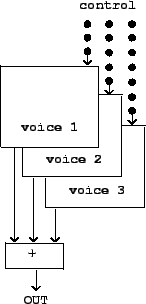 |
In music, the term polyphony is usually used to mean ``more than one separate voices singing or playing at different pitches one from another". When speaking of musical instruments (electronic or otherwise), we use the term to mean ``maintaining several copies of some process in parallel." We usually call each copy a ``voice" in keeping with this analogy, although the voices needn't be playing separately distinguishable sounds.
In this language, a piano is a polyphonic instrument, with 88 ``voices". Each voice of the piano is normally capable of playing exactly one pitch. There is never a question of which voice to use to play a note of a given pitch, and no question, either, of playing several notes simultaneously of the same pitch.
Most polyphonic electronic musical instruments take a more flexible approach to voice management. Most software synthesis programs (like csound) use a dynamic voice allocation scheme, so that, in effect, a new voice is created for every note in the score. In systems such as Max or Pd which are oriented toward real-time interactive use, a voice bank is allocated in advance, and the work to be done (playing notes, or whatever) is distributed among the voices in the bank. This is diagrammed in Figure 4.8.
In this example the several voices each produce one output signal, which are all added to make the total output of the voice bank. Frequently it will occur that individual voices need several separate outputs; for instance, they might output stereo so that voices may be panned individually; or they might have individual effects sends so that each may have its own send level.